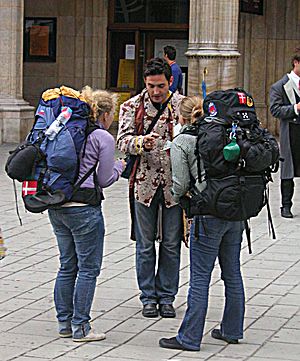Backpacking (travel) facts for kids
Backpacking is a cool way to travel. It means going on a trip, usually for a long time, while carrying your stuff in a light backpack. People who travel this way are called backpackers. They often try to keep their costs low and travel independently.
The cost of a backpacking trip depends on how long you travel. Backpackers need money for food, a place to sleep, and getting around. They save money by choosing cheap places to stay. This often includes youth hostels.
One well-known group is the Youth Hostels Association (YHA). Many hostels are part of YHA and follow similar rules. The price for a night can be anywhere from $10 to $60. This depends on the room type and time of year.
Sometimes, backpackers find even cheaper places to stay. They might book a room as a "paying guest" in someone's home. Websites like Airbnb help travelers find these low-cost options.
Backpackers often connect with each other. They share tips and information. They might find details online or on bulletin boards at their hostels. They share advice on how to reach places easily. They also tell each other about good shops or restaurants.
Some backpackers even try couch surfing. This means staying for free at a local person's house. It's a great way to meet new people and save money. Many areas have "Backpackers Groups" that plan trips together all year.
In some countries, like Ireland, Australia, Canada, New Zealand, and the United Kingdom, special visas let backpackers work. This helps them earn money to support their travels.
Contents
The History of Backpacking Adventures
People have carried their belongings on their backs for hundreds of years. But the idea of modern backpacking started more recently.
Early Backpackers and Famous Trails
One of the first known backpackers might have been Giovanni Francesco Gemelli Careri. He was an Italian adventurer in the 1600s.
The modern idea of backpacking really grew in the 1960s and 1970s. This was with the "Hippie Trail." This trail followed parts of the old Silk Road in Asia. Some backpackers still follow parts of this famous route today.
Over the past few decades, many backpackers have explored Southeast Asia. Popular islands in Thailand and quiet towns in Cambodia and Laos have changed a lot. This is because so many travelers visit them. Backpacking is also popular in Europe, South America, Central America, Australia, and New Zealand. There are many well-known routes that backpackers often follow around the world.
How Technology Changed Backpacking
Technology has also changed how people backpack. In the past, backpackers did not carry expensive electronics. They worried about theft, damage, or extra weight. Things like laptop computers, digital cameras, and PDAs were rare.
But now, people want to stay connected. Also, electronics have become much lighter. This has led to a new trend called "flashpacking." Flashpackers still travel on a budget, but they bring more tech gadgets.
Traditionally, backpackers used large backpacks, usually 30 to 60 liters in size. Today, some travelers use roller suitcases. There's also a trend to keep pack weights under 7 kg. This is because many airlines have a 7 kg limit for carry-on bags.
See also
 In Spanish: Mochilero para niños
In Spanish: Mochilero para niños



